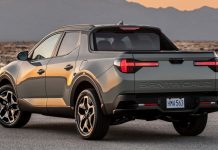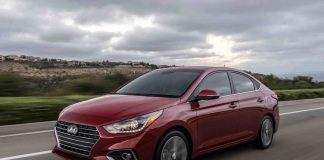There are two hybrid models on the market that address what’s arguably the most persuasive argument against buying a new hybrid:
They cost too much.
Or, to put a finer point on it: Their cost to buy is too high relative to what you’ll save on fuel. A new Toyota Prius, for instance, has a base price of $24,200 and for that you get 51 city, 48 highway – which is very good. But for about $14k, you could also buy a conventional non-hybrid economy car like the new Nissan Versa Note hatchback (decently equipped, too – with AC and all the necessaries) and get 31 city, 40 highway. Which isn’t quite as good, of course. But you’ll also have spent $10,200 less up front – the difference in price between the Prius and the Versa – which you can then put toward gas.
How many years of driving will it take before the Prius actually saves you money vs. the Versa – as opposed to merely using less gas?
Enter the Honda Insight hybrid – and its similarly budget-conscious rival, the Toyota Prius C. Both cost much less than other hybrids: $18,725 (base price) for the Honda and $19,080 for the Toyota. They also get very good gas mileage – 41 city, 44 highway in the case of the Insight. And the roughly $4,000 you save “up front” on either relative to a standard Prius (or Ford C-Max/Fusion hybrid) makes the Insight’s “down the road” economy all the more, well, economical.
But is the Insight a better choice than the Prius C?
The Insight is a five-door hatchback with a hybrid gas-electric powertrain. It is a larger vehicle overall than its price-equivalent rival, the Toyota Prius C – but the C actually has more space for passengers inside (as well as a roomier back seat) and its fuel efficiency is superior: 53 city/46 highway vs. 41/44 for the Insight.
The Honda’s base price of $18,725 is however slightly lower than the Prius C’s base price of $19,080 – and you’ll probably be able to wrangle a better deal on the Insight because of the Toyota’s greater popularity.
WHAT’S NEW
The Insight has received a few minor but worth-mentioning tweaks, including an exterior and interior cosmetic refresh (new front and rear clips, grille design, tail lights; revised gauge cluster, etc.) and slightly wider tires – to improve the car’s handling.
Cost to buy is not too far removed from the cost of a well-equipped non-hybrid economy car – so you save money overall (and sooner).
Sportier-looking (and driving) than either Prius.
Better mileage on the highway than in town.
Honda dealers more likely to haggle than Toyota dealers.
Prius C’s city/highway mileage stats are better – and its back seat is roomier.
Not-so-powerful powertrain sometimes sweats (and squeals) trying to keep up with traffic.
Not as easy to park in tight spots as shorter-overall Prius C.
UNDER THE HOOD
The Insight’s hybrid powertrain consists of a 1.3 liter gas engine teamed up with a 10 Kw electric motor and nickel-metal hydride (NiMh) battery pack. The gas engine produces 88 hp and the electric motor/batteries the equivalent of 13 more – for a combined total output of 98 hp and 123 ft.-lbs. of torque.
A continuously variable (CVT) automatic is the standard transmission. CVTs are fully automatic, but don’t shift through a fixed series of forward gears like a conventional automatic. Instead, they continuously vary the “gear” you’re in at any given moment to make the most of the engine’s power – and to maximize efficiency. This is achieved by using a pair of adjustable pulleys and a drive belt; the pulleys increase or decrease their diameter to alter the “gear” you’re in, based on how fast you’re going and how hard you’re pushing down on the gas pedal. The chief noticeable difference between a CVT and a conventional automatic is there’s no sensation of up (and down) shifts. The car accelerates forward, almost turbine-like. The downside – vs. a conventional automatic – is (usually) more noise from the engine, which (when you floor it) will typically rev to fairly high RPM and remain at that RPM until you back off the gas. More on this below.
The EPA gives the Insight a 41 city/44 highway rating – well below the Prius C’s 53 city, 46 highway. Part of the reason for the Insight’s comparatively mediocre economy is that its nickel-metal-hydride batteries are not as efficient as the latest-generation (lithium ion) batteries.
Notice that the Insight’s city mileage is actually slightly less than its highway mileage. Typically, hybrids (including the Prius C) do better in city-type, stop-and-go driving than they do on the highway – the opposite of most non-hybrid cars.The Insight is one of the few hybrids that performs better – fuel-efficiency-wise – on the highway than it does in city-type driving. This could be an important factor in your deliberations, if you do more (or even a lot) of highway driving relative to stop-and-go, city driving.
Acceleration in any situation is gimpy at best.
It takes the Insight about 11 seconds – under ideal conditions – to reach 60 MPH. The good news – for Honda – is that the Prius C is equally lacking in the thrust department. If you’re looking for something that moves – that’s also a hybrid – you might want to take a look at the Ford C-Max. Just be advised that it’s far more expensive ($25,465 to start) and its mileage (45 city and only 40 on the highway) is not much to cheer.
ON THE ROAD
Like the Prius C (and the regular Prius) the Insight can trundle along on its batteries and electric motor alone for about a mile or so on a full charge at speeds up to about 30 mph . . . if you accelerate very gingerly and the road is absolutely flat. Anything more than eggshell pressure on the pedal – or an uphill climb – and the gas engine will automatically kick on to keep you moving.
It will just as automatically turn itself off again when the vehicle is stationary – with accessories (the radio, fan, etc.) powered electrically. The gas engine comes back on once again whenever throttle pressure (or depleted battery charge) demand additional power – including electrical power. The gas engine – in addition to propelling the vehicle – does double duty as a kind of onboard generator, juicing up the batteries as you drive. The mechanical energy of forward motion (and braking) is also captured and transformed into electrical energy, which is fed to the batteries as you drive. It’s a closed-loop system, which has one very big benefit relative to an electric car: You will never run out “juice” (electrical power) so long as you don’t let the car run out of gas.
The Insight’s CVT transmission has Sport and Econ modes; “shifts” can also be controlled manually via F1-style paddle shifters (on EX trims) located on the steering wheel. These basically let you hold the transmission in a more aggressive setting for at least the feel of better acceleration. But the car’s 11 second-to-60 performance is about 2 seconds off the pace of almost any current non-hybrid economy car.
Handling – especially cornering – is pretty good, though. As hybrids go, anyhow.
This is probably because the Insight is a Honda – and Hondas (all of them) have more athletic responses than Toyotas. The steering feels quicker and less vague and the suspension’s calibrations are firmer, which ties the car down better when you dive into a curve at a speed above the typically dumbed-down speed limit. There’s less heaving (that sensation of weight hurling itself toward the outside of the curve) and also less early-onset tire squeal (a Prius characteristic).
Few people buy a hybrid for its high-speed cornering prowess. But the Insight does give you more as a car – as opposed to an appliance.
The Insight looks like a hybrid but it’s not as obviously a hybrid as the Prius – nor as deliberately Geek Squad in terms of its controls.
It has, for example, a conventional key ignition and a floor-mounted shifter (the Prius has a Game Boy-esque toggle thing mounted on the center console that takes some getting used to). The digital readout speedometer has green-blue backlighting that shifts from deep green (most economical) to shades of blue (less economical) depending on how hard you’re working the powertrain – as a sort of visual cue to encourage high-mileage driving.
There is also a smaller display that you can scroll through by pressing the “i” button on the steering wheel to learn such things as instant and average economy as well as range and (like the Prius) whether you’re using the electric motor/batteries, the gas engine, or both.
The AC system is controlled by rotary knob to the right of the steering wheel, with fan speed just above that. No mice or menus to negotiate. If you want defrost or heat or whatever, you just turn the knob to the appropriate setting.
The rear doors are cut deeply into the back quarter panels and this makes them open extra wide and also creates a big opening to ease getting in and getting out. There’s not quite as much room back there once you’re in, though. On this score, the Prius C has a definite advantage, with 2 inches more rear seat legroom (35 inches vs. 33 inches for the Honda) and about half an inch more backseat headroom (37 inches for the Toyota vs. 36.4 for the Honda).
The back part of the Insight is a lot like what used to be called a Kammback layout, meaning the roof slopes gradually backward where it meets up with a fairly tall/vertical tail section – most of which lifts up when you raise the hatchback. This layout increases useable cargo space with the hatchback down, too (31.5 cubic feet, max) and also gives the interior a roomy and open feel. Up front, there’s a standard tilt and telescoping steering wheel and height adjustable driver seat – all of which help make the most of the available space.
THE REST
During the week I had the Insight, the car consistently returned an average of 35-38 mpg driving at roughly 3,200 ft. and dealing with hilly terrain and average speeds around 50 MPH. This is very good – keeping in mind the “average” aspect. A conventional (non-hybrid) economy car such as the Versa Note mentioned earlier can almost match the Insight’s mileage on the highway – but its overall average mileage is about 5 MPG less. Over time, that difference can save you a not-small amount of money – especially in relation to the not-very-great price difference between the Insight and a car like the Versa Note. It is much harder to make the economic argument in favor of the pricier Prius (not the C) whose efficiency advantages are quite possibly not enough to “work off” the thousands of dollars in higher up-front costs.
I’d still like to see Honda re-introduce the original (2000-2006) Insight – a two-seater coupe that came with a manual transmission and which could (I know, because I did) hit 70 MPG if driven hyper-mile style.
But the coupe came out before everything went to hell. When the housing bubble was still bubbling – and when gas was still under $2 a gallon. It didn’t sell well – for obvious reasons – and Honda cancelled it.
Today, with gas still well over $3 a gallon – and the economy (despite all the Happy Talk) still as dead in the water as it was last year (or the year before that) a 70 MPG scooter like the original Insight would probably sell like – well, hotcakes.
The current Insight is well-equipped for commuter/everyday use – with standard AC and a decent CD-playing stereo with MP3 port.
Another item: The brakes are disc/drum – which is arguably a plus in terms of service life and cost to service. Drum brakes are more durable; there are also no expensive rotors to warp or $300 calipers to replace. Drum brake shoes often last 50,000 miles or more, too. Pads usually wear out sooner.
Disc-disc layouts do usually provide better (shorter) stops, but the Insight’s disc/drum layout is perfectly adequate for the type of driving this vehicle is likely to see.
Final point of order: Because it’s not got the Prius Halo – and because its gas mileage isn’t quite as good as the Prius C’s – it’s very likely you’ll be more successful whittling down the sticker price of this car than you would the Toyota. The success of the Prius has made Toyota dealers pretty insolent about charging full MSRP – because they can get away with it.
Honda dealers know they can’t – and that’s something to consider. If you can knock say $1,500 off sticker – while your neighbor pays full sticker for his C – the mileage advantage he has over you is ultimately irrelevant. You both end up paying about the same.
And it’s very possible you could end up paying less.
THE BOTTOM LINE
If you’re looking for a new hybrid that’ll save you money as well as gas, the Insight’s definitely worth checking out.
Throw it in the Woods?
Eric Peters is a veteran car journalist and author of Automotive Atrocities and Road Hogs. If you like what you’ve been reading here, please consider supporting EPautos.com – we’re a reader-supported outfit and depend on you to keep the wheels turning.
Our donate button is here. For those not Pay Pal-inclined, you can mail us at the following:
EPautos
721 Hummingbird Lane SE
Copper Hill, VA 24079

















Dear Doug,
That’s impressive!
Which model do you have? The 3 door or 5 door?
How does it compare with the Mini in overall bang per buck?
I have the 3 door. The Mini is a direct competitor with the A1 but the only time I have been in one was when a guy drove me around the Nürburgring in his Race Mini. My A1 couldn’t begin to compare with his.
I have done some modifications to the car but engine-wise, have only added a Speedbuster Chipbox which lifts the Horsepower to arount 152 with Super+ fuel – since only Super is available in the Americas, the power is a bit less. Last year, I drove to Las Vegas from Guadalajara and (according to the car computer) burned 7,1L/100Km (about 33MPG) – pretty good since the Autopista has many toll booths and nearly always ends at major towns. Once I crossed the Border, the consumption dropped into the 6’s but, in AZ or NV, I only needed to stop for fuel and seldom drove over 85MPH.
Dear Doug,
I’ve seen one or two A1s on the street here on Taiwan, but mostly the A1 has flown under my radar.
Lots of MINIs on the other hand, including the Cooper and the Cooper S.
The larger “Countryman?” To me that’s a non compute. Who wants a large MINI? If I wanted a larger car, a “MAXI” as it were, I wouldn’t get a MINI!
Anyway your comment underscored that the Audi A1 definitely ought to be on any short list for that form factor. Impressive.
You can thank that piece-of-shit Lyndon Johnson and his lying, self-serving Congress for making it illegal for US residents to purchase whatever car they wish. If this former freedom had continued, they wouldn’t have to decide between these and the other warm turds their leaders have decided they can have.
My 2013 Audi A1 officially consumes 36,2 MPG City and 51,1 MPG Highway, accelerates 0 to 61MPH in 8,9 (7,9 with a Speedbuster Chipbox), tops out at over 200 Km/h and cost $21.000 (including the 16% Mexican sales tax).
How did you stay awake test-driving this thing?
Right you are, Doug…. if only more people knew just how severely their choices have been constrained – “for their own good,” of course – by politicians and bureaucrats.
I just looove the styling, stick it in the bed of my pickup, throw a tarp over it and the mileage will be GREAT!
Ha!
Ok, now for my personal view (as opposed to my objective car journalist evaluation):
The original Insight was the proverbial spots on the leopard. Ideal year-round commuter car; like a motorcycle, almost – except you had all-weather protection, heat (and AC) and the ability to carry (comfortably) a passenger.
That thing was capable of 60 MPG – better than any current hybrid and better than most motorcycles, too.
This Insight can make a case for itself against something like the Prius or the Fusion hybrid (and so on). But if you are really aiming to save bucks on driving, here’s my best advice:
Budget about $7,500 for a good used economy car – something like a Corolla or Versa, about four years old, with about 50,000 miles on it. And drive the little SOB for the next ten years and 150k. Then sell it for $2,000 to some high school kid (who will be happy to have it)… and pat yourself on the back for being financially savvy.
Guess I’m just picking an old scab. I suppose styling is written by law now, like everything else. It does beat a Prius hands down though. Those things are butt ugly from any direction. Like my daddy told me one day when I was playing the guitar, if you keep picking it, it’ll never get well. If you lived in town you’d want to add that garage in back so you could drive down the alley.
You’re right that the higher hybrid price doesn’t make a lot of sense, unless you drive a lot of miles year after year. The more you drive, the sooner the high mpg advantage will enable you to reach a break even point…and then, to start saving.
But there are a lot of Prius/Insight buyers, who don’t drive that many miles a year. Some of them may just be expressing their “social conscience” for others to see. But I think a good number of buyers view their high mpg hybrids as a “hedge” against the real possibility the gas prices may skyrocket.
Won’t take too long to hit that break even point if gas goes to $6.00 per gallon. Hybrids would be even more valuable if serious gas shortages occurred.
You can’t wait to buy a hybrid “after” these things occur. At that point, the dealers will price gouge so bad that it would be hard to ever hit that break even point.
In this way, you could view hybrid ownership the same way you view having insurance…or owning a gun. You hope you will never really need it, but it’s good to have it.